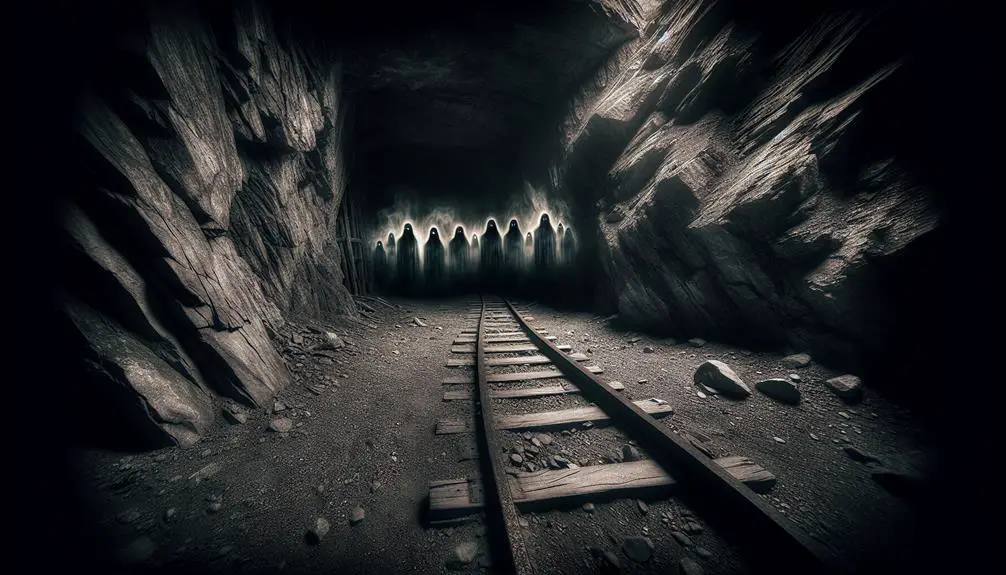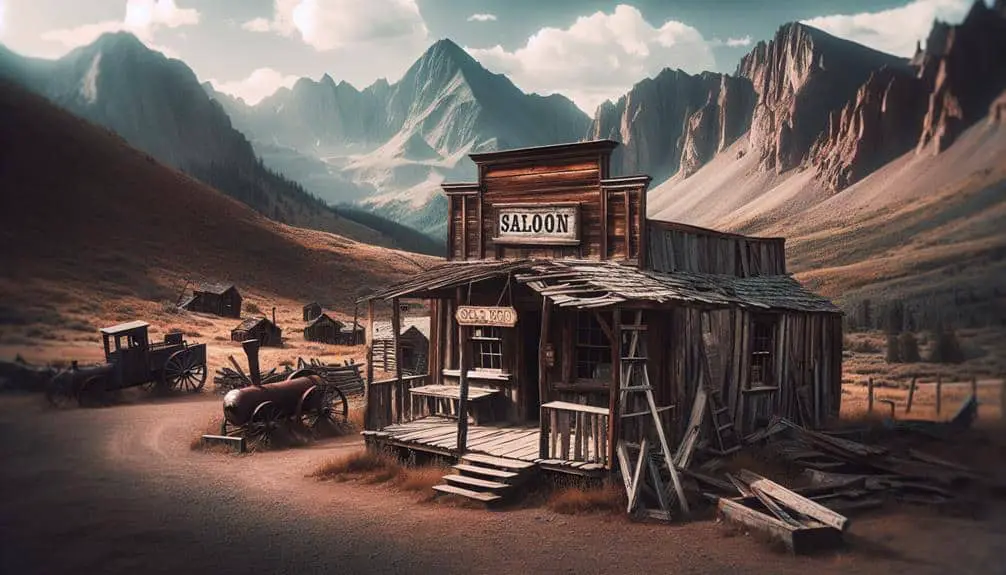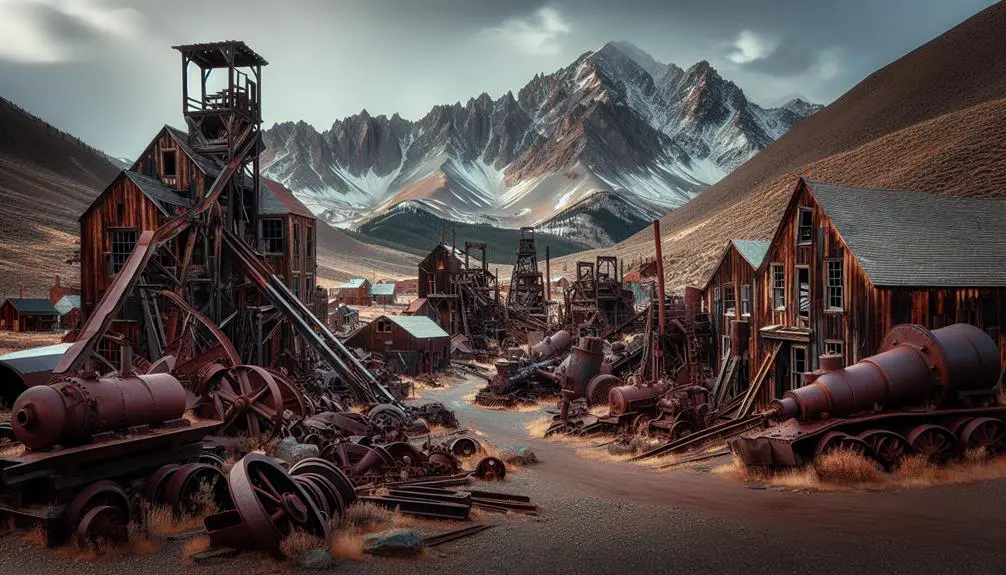Remote Colorado mining camps remain ghostly due to their rich history, environmental impact, natural reclamation, harsh weather, and preservation challenges. These camps were once bustling with activity, but now stand silent, echoing the past. Abandoned mines pose dangers, while natural processes slowly reclaim the land. Harsh weather exacerbates decay, adding to the eerie atmosphere. Preservation efforts face hurdles, hindering restoration. The layers of complexity surrounding these camps create a haunting aura, drawing you into a world frozen in time, waiting to reveal more.
Key Points
- Abandoned mines create an eerie atmosphere with decaying structures and desolate landscapes.
- Local folklore perpetuates ghostly legends, adding mystery and intrigue to the deserted camps.
- Isolation and harsh weather conditions deter visitors, contributing to the ghostly ambiance.
- Limited preservation efforts allow nature to reclaim the sites, enhancing their ghostly appearance.
- Economic decline and environmental hazards repel development, perpetuating the ghostly nature of these camps.
Historical Significance of Remote Camps
The historical significance of remote mining camps in Colorado lies in their role as vital hubs for early frontier exploration and resource extraction. These camps were instrumental in fueling the rapid growth and development of the region by providing a base for miners, prospectors, and pioneers. Through archaeological discoveries, we gain insights into the daily lives of those who braved the harsh conditions in search of valuable minerals like gold, silver, and copper. These findings help piece together the puzzle of Colorado's mining history, shedding light on the challenges and triumphs of the people who shaped the landscape.
Moreover, local folklore surrounding these remote mining camps adds another layer of intrigue to their historical importance. Tales of lost treasures, ghostly encounters, and daring escapades contribute to the mystique that surrounds these abandoned sites. By delving into both the tangible remnants left behind and the intangible stories passed down through generations, we can better appreciate the lasting impact of these remote Colorado mining camps on the state's heritage.
Impact of Abandoned Mines
Surveying the impact of abandoned mines reveals a complex web of environmental, safety, and economic repercussions. Abandoned mines pose significant environmental hazards, such as water contamination from toxic chemicals and heavy metals leaching into the soil. These environmental impacts can persist for decades, affecting ecosystems and water sources in the vicinity. In addition, the physical structures of abandoned mines can pose risks to public safety, with dangers such as collapsing shafts, unstable ground conditions, and the potential for toxic gas buildup.
Besides the immediate safety concerns, the presence of abandoned mines can also have economic implications. The costs of securing and remediating these sites fall on government agencies and taxpayers, diverting resources from other critical needs. Additionally, the negative perception of areas with abandoned mines can deter potential investors and developers, hindering economic growth and community revitalization efforts. Addressing the environmental hazards and public safety risks associated with abandoned mines is important to mitigating their long-term impacts on both the natural environment and local communities.
Natural Reclamation Processes
Examining the natural reclamation processes of abandoned mines reveals a fascinating interplay between ecological restoration and environmental recovery. Plant succession plays a vital role in this process, where different plant species colonize the disturbed land over time. Pioneer species like grasses and shrubs are among the first to establish themselves, helping to stabilize the soil and create a foundation for more complex plant communities to develop. Through a series of stages, known as seral stages, plant succession gradually transforms the barren mine sites into thriving ecosystems.
Additionally, erosion control is a key component of natural reclamation. As vegetation becomes established, the roots of plants help bind the soil together, reducing the risk of erosion caused by wind and water. This process not only protects the landscape but also promotes the return of wildlife to the area. By allowing natural reclamation processes to unfold, abandoned mine sites can undergo remarkable transformations, showcasing the resilience and adaptability of nature.
Influence of Harsh Weather Conditions
Despite the progress made through natural reclamation processes, the harsh weather conditions in remote Colorado mining camps greatly impact the ecological restoration efforts. Extreme isolation and survival challenges further exacerbate the already harsh conditions, hindering restoration initiatives. The unforgiving climate in these remote areas subjects the abandoned structures and landscapes to intense weathering, impeding the recovery of the ecosystem.
The extreme isolation of these mining camps amplifies the impact of weather conditions on the restoration work. Heavy snowfall, freezing temperatures, and strong winds not only deteriorate the remaining structures but also make it challenging for restoration teams to access and work in these areas. The survival challenges posed by the harsh weather conditions create additional obstacles for sustaining any progress made in ecological restoration efforts.
Preservation Efforts and Challenges
Preservation initiatives in remote Colorado mining camps face significant challenges due to the harsh weather conditions and isolation, impacting the ongoing restoration efforts. The extreme weather patterns, including heavy snowfall and freezing temperatures, deteriorate the structural integrity of buildings and infrastructure, making preservation a challenging task. Community engagement plays an important role in these efforts, as local support helps raise awareness and garner resources for restoration projects. However, the isolation of these camps hampers community involvement, limiting the pool of volunteers and resources available for preservation work.
Funding sources also present a major obstacle to the preservation of these historic sites. Securing financial support for ongoing maintenance, repairs, and conservation efforts is a constant struggle. Limited access to grant opportunities and the high cost of transportation to remote locations further complicate funding challenges. To ensure the long-term preservation of Colorado's mining camps, innovative strategies for community engagement and sustainable funding sources must be developed.
Frequently Asked Questions
How Did the Remote Mining Camps in Colorado Contribute to the Local Economy During Their Operation?
During their operation, remote mining camps in Colorado greatly boosted the local economy. The economic impact was substantial, fostering community development through job creation, infrastructure growth, and increased trade, laying the foundation for future prosperity.
What Are the Potential Environmental Hazards Associated With Abandoned Mines in Remote Areas?
When you examine the potential hazards of abandoned mines in remote areas, you'll find that the reclamation process is essential to mitigating environmental impact. Without proper care, these sites can pose risks for generations.
How Long Does It Typically Take for Natural Reclamation Processes to Occur in Abandoned Mining Sites?
Ecological succession is a natural process in which abandoned mining sites are gradually reclaimed by nature over time. The time frame for this varies depending on factors like soil quality and climate.
What Specific Weather Conditions in Colorado Make It Difficult for Remote Mining Camps to Be Preserved?
You wonder about the specific weather conditions in Colorado that challenge preservation efforts at remote mining camps. Harsh conditions like extreme cold, heavy snowfall, and high winds contribute to the difficulty in maintaining these historic sites.
What Are Some of the Main Challenges Faced by Preservation Efforts to Maintain Remote Mining Camps in Colorado?
Preservation challenges for remote Colorado mining camps stem from harsh weather, isolation, and limited resources. Efforts to maintain these sites are vital due to their historical significance, requiring innovative strategies to safeguard their integrity.



